Detecting tiny cameras in homes using light reflection analysis is a powerful security technique. By observing unique lighting patterns and distortions, homeowners can identify hidden devices, enhancing privacy protection for personal spaces using Tiny Cameras for Home Monitoring. This method offers an innovative solution against discreet surveillance equipment.
Uncover the subtle art of detecting hidden spy cameras with our guide on advanced light reflection techniques. Learn how understanding the science behind light behavior can expose even the tiniest surveillance devices in your home. From identifying micro-cameras to implementing effective countermeasures, this article equips you with essential knowledge for enhanced home monitoring. Discover practical strategies and stay ahead of potential privacy breaches using innovative methods like analyzing light reflections.
- Understanding Light Reflection for Spy Camera Detection
- Techniques to Identify Tiny Cameras in Homes
- Enhancing Home Monitoring: Effective Spy Camera Countermeasures
Understanding Light Reflection for Spy Camera Detection
Understanding Light Reflection is a key component in detecting hidden spy cameras, especially when it comes to tiny cameras used for home monitoring. These miniature devices, often no bigger than a button, can be difficult to spot with the naked eye. However, they reflect light differently than legitimate fixtures or objects in a room. By analyzing these reflections, skilled individuals can identify suspicious activity and potential hidden surveillance equipment.
The technique leverages the fact that light interacts with surfaces in predictable ways. When light hits an object, it bounces off at various angles depending on its surface properties. Spy cameras, often with reflective lenses or internal components, will produce unique patterns of reflection that can be detected by observing changes in light intensity and direction. This method is particularly effective in low-light conditions, making it a valuable tool for thorough home security assessments using tiny cameras for monitoring purposes.
Techniques to Identify Tiny Cameras in Homes
Identifying tiny cameras hidden within homes has become a crucial aspect of home security and privacy protection. These miniature devices, often referred to as spy cameras, can be difficult to detect with the naked eye due to their compact size and advanced technology. However, several innovative techniques have emerged to counter this growing threat.
One effective method involves analyzing light reflections and shadows cast by objects in a room. Spy cameras, especially those with infrared capabilities, may produce unique lighting patterns or subtle distortions when reflected sunlight encounters their lenses. By observing such anomalies and comparing them to known camera characteristics, individuals can become more adept at locating these hidden devices. Additionally, specialized equipment that detects heat signatures can be employed, as many spy cameras generate distinct thermal readings, aiding in their identification within residential spaces.
Enhancing Home Monitoring: Effective Spy Camera Countermeasures
In today’s digital age, tiny cameras for home monitoring have become a concern for privacy-conscious individuals. The rise of sophisticated spy camera detection techniques is a game-changer in safeguarding personal spaces. One innovative method leverages light reflection to uncover hidden surveillance devices. This approach involves strategically placing reflective surfaces that can detect unusual light patterns, often emitted by the infrared sensors common in spy cameras.
By integrating this countermeasure into home security systems, residents can enhance their monitoring capabilities. The technique is particularly effective against tiny cameras, which are often discreetly placed and may go unnoticed. This proactive step ensures that personal moments remain private, fostering a sense of security and peace of mind for homeowners.
The spy camera detection light reflection technique offers a proactive approach to enhancing home monitoring. By understanding how light interacts with these tiny cameras, homeowners can implement effective countermeasures to protect their privacy. With the right tools and knowledge, it’s now possible to identify and neutralize hidden surveillance devices, ensuring a safer and more secure living environment.
